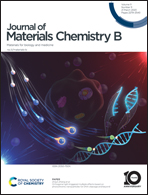Synthesis of l-aspartic acid-based bimetallic hybrid nanoflowers to immobilize snailase for the production of rare ginsenoside compound K†
Abstract
The conversion of the common ginsenoside Rb1 to the rare ginsenoside compound K (CK) using snailase (Sna) is an efficient method for industrial production. In order to improve the stability and recoverability of Sna during the catalytic conversion of ginsenosides, the cage-like immobilised Sna material ZIF-ZnCo-Sna and the hybrid nanoflower-based immobilised Sna material Asp@ZIF-ZnCo-Sna modified with L-aspartic acid (Asp) were synthesised using a one-step method. The addition of Asp provides a richer ligand pattern and the morphology of the material changed from a cage to a hybrid nanoflower. The modified hybrid nanoflower Asp@ZIF-ZnCo-Sna has a larger specific surface area, resulting in an enzyme loading of 142.57 mg g−1. The more abundant mesopores allowed the enzyme to maintain a good conformation and the enzyme activity was 79.8% of that of the free Sna. In addition, the total conversion rate of Asp@ZIF-ZnCo-Sna to ginsenoside Rb1 was as high as 88.35%, whereas that of ZIF-ZnCo-Sna was 79.12%. Moreover, after 6 cycles, the catalytic conversion of ZIF-ZnCo-Sna and Asp@ZIF-ZnCo-Sna and the crystalline shape remained the same, indicating that both composites have good stability and catalytic properties. This new approach of improving the MOF morphology and enzymatic activity by a one-step addition of small biological molecules provides a simple, rapid, and effective strategy for biocatalysis. It also provides a certain reference value for the immobilized Sna to produce rare ginsenoside CK.

- This article is part of the themed collection: #MyFirstJMCB


 Please wait while we load your content...
Please wait while we load your content...